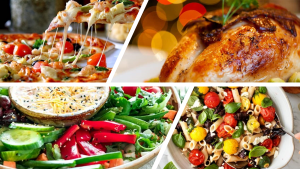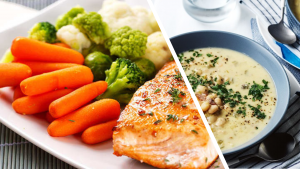The COVID-19 pandemic has raised the issue of disease prevention through healthy lifestyles and nutrition. Specifically, how much can nutrition help against this disease?
Scientific evidence indicates that subjects at high risk of COVID-19 are the elderly, particularly if they are hypertensive, overweight, diabetic or frail.
 There is also evidence that hypertension, diabetes and obesity, as well as smoking and sedentary lifestyles, are the major risk factors for heart attacks, strokes and cancer, as well as for many other diseases, such as colds, liver, pancreatic, bone, gastrointestinal and urinary track diseases. To understand the extent of the phenomenon, just remember that following an appropriate lifestyle protects against at least 90% of deaths from heart attack and 93% from diabetes.
There is also evidence that hypertension, diabetes and obesity, as well as smoking and sedentary lifestyles, are the major risk factors for heart attacks, strokes and cancer, as well as for many other diseases, such as colds, liver, pancreatic, bone, gastrointestinal and urinary track diseases. To understand the extent of the phenomenon, just remember that following an appropriate lifestyle protects against at least 90% of deaths from heart attack and 93% from diabetes.
Advanced age is the main factor of increased risk of COVID-19 death, especially over the age of 70. Male gender, as well as age, is a non-eliminable risk factor, although much less important.
We are interested in discovering “how much” we can reduce the risks related to COVID-19 by following a healthy lifestyle. How difficult it is to adopt a healthy diet and follow it, which becomes our ally? Let us proceed in order:
- Obesity: it triples the risk of death following COVID-19 infection. For example, out of 100 normal weight people infected with COVID-19, 7 die, while out of 100 infected obese people, 20 die. This is largely due to the many diseases related to obesity, such as heart and kidney disease.
- Hypertension: it doubles both the risk of COVID-19 infection and the risk of death following the infection. Out of 100 normotensive people infected with COVID-19, 7 die, while out of 100 hypertensive people, 14 die.
- Diabetes: it increases the severity of Coronavirus disease and doubles the risk of death from infection. As previously mentioned, out of 100 non-diabetic people infected with COVID-19, 7 die, while out of 100 diabetic people 14 die.
- Dyslipidemia, kidney, heart and respiratory diseases: each condition strongly increases the risk of death compared to healthy people (taking into consideration: same age and sex).
Which considerations?
 The COVID-19 pandemic is a global danger. It kills. One third of the people who have died from COVID-19 did not have any of the risk factors mentioned above. Thus, it is not possible to avoid the danger of death posed by the infection (very accentuated over the age of 70), by implementing only the measures, albeit optimal, of nutrition and lifestyle. The use of a mask, hand cleaning and a certain social distancing are also required.
The COVID-19 pandemic is a global danger. It kills. One third of the people who have died from COVID-19 did not have any of the risk factors mentioned above. Thus, it is not possible to avoid the danger of death posed by the infection (very accentuated over the age of 70), by implementing only the measures, albeit optimal, of nutrition and lifestyle. The use of a mask, hand cleaning and a certain social distancing are also required.
With proper nutrition, however, we can really halve the risk of death in the event of infection and, probably, halve the risk of infection, even if acquired asymptomatically or with mild symptoms.
Scientific research has made some definite considerations regarding the above-mentioned pathologies:
Hypertension: the international guidelines indicate a lifestyle change as the first therapeutic approach for stage 1 hypertension, as well as uncomplicated stage 2 hypertension. No medication, just diet! The foods to be introduced are wholemeal products, fish, yogurt, legumes, white meat, fruit, vegetables, nuts, a glass of wine, decaffeinated coffee, cocoa (such as dark chocolate, not hazelnut cream). Foods to be consumed occasionally are: sweet and carbonated drinks, colas, fried foods, red meats, especially in the form of hot dogs and cold cuts with casings, rich in salt and added fats, cheese, alcohol and sweets, especially if prepackaged or of poor quality. Preference should be given to 100%-cured meats (prosciutto crudo, bresaola, speck), rather than those with casings or “processed” (salami, mortadella…). Eliminate caffeine (decaffeinated coffee is excellent) and liquorice. Reduce salt. Of course, refrain from smoking and practice moderate physical activity.
Diabetes: little benefit is gained from medication alone compared to the use of an excellent diet! With the exclusion of those who have to take insulin, lifestyle is far superior to the effectiveness of anti-diabetic medication! For non-experts, it may be surprising how the diet in the case of diabetes is qualitatively very similar to that for hypertension (apart from liquorice, colas and coffee), so much so that it is unnecessary to further specify here, except that , Diabetics are often overweight or obese, so a slight weight loss is helpful (5-8 kg).
Note: a patient on dialysis or pre-dialysis is an exception to this extraordinary similarity of dietary indications, where the diet is almost opposite, so please refer to the hospital dietician.
Obesity: there is no absolute need to reach an “ideal weight”. In fact, there are “healthy fats” and ” dysmetabolic leans”. It is therefore necessary to orient ourselves towards being fit, both in thin people and in those who have an extra 10 or 20 kg. This depends on the lifestyle, more on what you eat, and not on how much you eat, in addition to non-smoking and sports. In fact, only morbid obesity is seriously detrimental to longevity (indicatively over 25-30 kg of extra fat). The type of food already mentioned is also very important here. Here are some indications for those who want to lose weight: replace portions of bread, pasta, meat and cheese with lots of cooked and raw vegetables. Even several ounces at both lunch and dinner, in order to reach satiety. Reduce oil by a third, even if it is extra virgin olive oil, but never eliminate it completely, because the first cause of gallstones (gallbladder) is a drastic weight loss diet, especially without fat. Gradually reduce sweet and carbonated drinks, in favour of water and a glass of wine. Replace at least some bread and white pasta with wholemeal products and red meats with white meat or fish. Avoid excess meat and cheese by introducing more legumes into your diet. Decrease the fatty sauces. Prefer freshly squeezed juices or water, instead of fruit juices.
Diet example:
This dietary model is based on the “Mediterranean diet”, which assures a balanced supply of the nutrients we need.
 Breakfast: yogurt with cereals, alternatively bread or rusks with jam, preferably homemade. Partially skimmed milk, coffee (decaffeinated if hypertensive), green tea, or freshly squeezed juice. The biscuits to be preferred are those made with whole meal ingredients, with no added sugar and quality ingredients; in any case avoid exaggerating in quantities by not exceeding 7 ounces. It is also preferable to sweeten with honey, avoiding sugar.
Breakfast: yogurt with cereals, alternatively bread or rusks with jam, preferably homemade. Partially skimmed milk, coffee (decaffeinated if hypertensive), green tea, or freshly squeezed juice. The biscuits to be preferred are those made with whole meal ingredients, with no added sugar and quality ingredients; in any case avoid exaggerating in quantities by not exceeding 7 ounces. It is also preferable to sweeten with honey, avoiding sugar.
Morning snack: yogurt or a fruit, maybe alternate with cappuccino and brioches: at work, a break at the bar is pleasant. Even juice. In case of strenuous work, a sandwich with prosciutto crudo, bresaola, speck, water and coffee.
 Lunch: there is nothing that prevents women or men from eating a first and second course at lunch and dinner. In fact, it is preferable. Instead of a large portion of pasta or meat, half a portion of both. Regarding quantities, if your weight is fine, maintain it, otherwise apply the replacements and reductions seen above for obesity. Quality (whole meal products, pulses, vegetables, fish, dried fruit…) must not be compromised, and you must not give up on good food, i.e. you must always prepare delicacies. . Alternate the pasta with different sauces (meat sauce, tomato sauce, amatriciana, carbonara, pesto…), so that it is enjoyable, not a sacrifice! The same goes for the main courses and the side dishes. Remember that peas, chickpeas, lentils and beans replace meat and cheese very well (and have a low glycemic index and provide fibre).
Lunch: there is nothing that prevents women or men from eating a first and second course at lunch and dinner. In fact, it is preferable. Instead of a large portion of pasta or meat, half a portion of both. Regarding quantities, if your weight is fine, maintain it, otherwise apply the replacements and reductions seen above for obesity. Quality (whole meal products, pulses, vegetables, fish, dried fruit…) must not be compromised, and you must not give up on good food, i.e. you must always prepare delicacies. . Alternate the pasta with different sauces (meat sauce, tomato sauce, amatriciana, carbonara, pesto…), so that it is enjoyable, not a sacrifice! The same goes for the main courses and the side dishes. Remember that peas, chickpeas, lentils and beans replace meat and cheese very well (and have a low glycemic index and provide fibre).
Note: if there is a canteen where you work, use it, choosing food according to the criteria mentioned above, being careful that the cook does not mask the poor quality of the food with large quantities of oils and fats, condiments and flavorings. If there is no canteen, cook a little more in the evening to take to work the next day. In addition, always eat cooked or raw vegetables. A flavorful Italian pizza is good for you. Only diabetics should not exaggerate because of the high glycemic index.
Afternoon snack: same as the morning snack or with specific variations, such as tea or herbal tea.
 Dinner: same as lunch, perhaps try to use more digestible or “light” foods, such as soups, vegetable purees or cream soups. If choosing pasta, preferably whole meal pasta. Cream soups and purées represent a sort of middle ground between those who prefer first and second courses, and who prefer only the second. Prefer chicken, turkey, non-fried fish and legumes instead of red meats. Prefer hamburgers prepared the same day at the butcher’s. Whole meal bread. Alternate cooked and raw vegetables, fruit or nuts (but not peanuts, which are not easily digested). Water, a glass of wine for men, half a glass for women. Beer less frequently than wine, even white wine. Pizza once or twice a week (only problematic for diabetics). Bitters and spirits rarely. Coffee, decaffeinated for those who have sleeping issues.
Dinner: same as lunch, perhaps try to use more digestible or “light” foods, such as soups, vegetable purees or cream soups. If choosing pasta, preferably whole meal pasta. Cream soups and purées represent a sort of middle ground between those who prefer first and second courses, and who prefer only the second. Prefer chicken, turkey, non-fried fish and legumes instead of red meats. Prefer hamburgers prepared the same day at the butcher’s. Whole meal bread. Alternate cooked and raw vegetables, fruit or nuts (but not peanuts, which are not easily digested). Water, a glass of wine for men, half a glass for women. Beer less frequently than wine, even white wine. Pizza once or twice a week (only problematic for diabetics). Bitters and spirits rarely. Coffee, decaffeinated for those who have sleeping issues.

